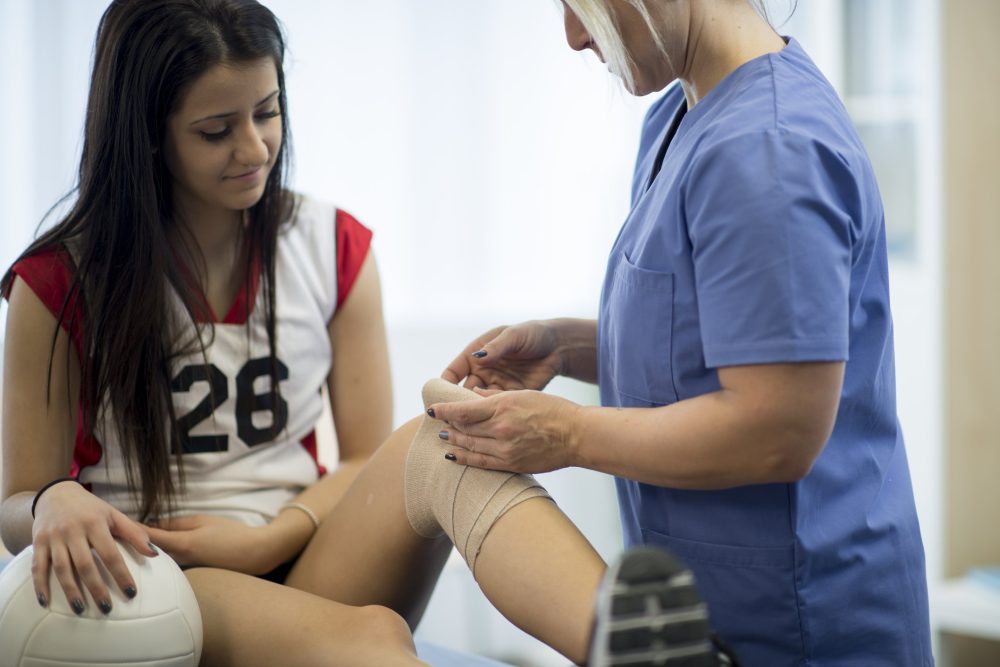
You’ve probably seen an athletic trainer at a sports complex or on the sidelines when you’re cheering on your favorite team.
Athletic Trainers are Multi-Skilled Medical Professionals
But, did you realize that athletic trainers play a critical role in the prevention of injuries? And then when an injury does happen, it’s often the athletic trainer who responds first. Athletic trainers play an essential role on a integrated care team because they are multi-skilled medical professionals. They must work together with other healthcare professionals to be certain that patients get the best possible care and can return to participating in physical activities.
Becoming an Athletic Trainer at Concordia University
Concordia University offers a robust Master of Science in Athletic Training program. While there used to be only one path to earning an M.S. in Athletic Training, Concordia now offers three paths toward earning this degree.
Three Paths to Becoming an Athletic Trainer:
- Enter as a freshman and do a five-year track. This path includes a Bachelor of Science in Sports Medicine and a Master of Science in Athletic Training.
- Enter as a freshman and do a four-year scholars track. You need to qualify for this program in order to apply. This path includes the Bachelor of Science in Sports Medicine and a Master of Science in Athletic Training.
- If you have a bachelor’s degree, enter the new, two-year, year-round M.S. in Athletic Training program. The first cohort started in the Summer of 2022.
What is the curriculum like?
Concordia’s Athletic Training program is accredited by the Commission on Accreditation of Athletic Training Education (CAATE).
The purpose of this program is to prepare graduates who are able to enter a variety of work settings and who can provide health care to diverse individuals who are engaged in physical activity. You can count on plenty of opportunities to interact with diverse patients in a variety of settings.
Learning by Doing
“Our program is very hands-on. As soon as students are admitted, they’re working with patients. We send them to clinical sites early on,” Program Director Dr. Kate Liesener said, referring to the experiential nature of the program. Students complete their clinical education experiences in a variety of settings, with a variety of patients. For example, there are many intercollegiate teams such as football, ice hockey, triathlon, and acrobatics and tumbling on Concordia’s own campus.
In addition to on-campus opportunities, Concordia has strong relationships with local high schools and industry partners. This means that students could find themselves on-site at a local high school or workplace setting, or they could be assisting the Milwaukee Fire Department.
What are the program outcomes?
- 3-Year Average of Graduates working as Athletic Trainers is 83%
- Graduates who choose not to work after graduation have pursued medical school, chiropractic school, physical therapy degrees, or doctoral programs
- Many of our graduates are employed with local high schools, universities, hospital settings, and professional sports teams
Athletic Training is a Rewarding Career
Dr. Liesener loves being an athletic trainer. She said, “In this role, you sometimes see people at their lowest moments. However, you also have the opportunity to see people at their highest moments. We get to see our patients frequently and help them along their road to recovery.”
Dr. Liesener enjoys the challenge that comes with being an athletic trainer. Each day is really dynamic, and you have to be engaged in the activity you’re supporting. Despite the excitement of not always knowing how your day will go, Liesener said by far that the personal connections with patients is the best part.
Athletic trainers can work in a variety of settings.
While your mental picture of an athletic trainer may have involved an athletic complex, there are other opportunities outside of traditional sports. Concordia’s students have been placed in a variety of settings, from the Milwaukee Fire Department to the Milwaukee Ballet.
Why should students come to Concordia for their MSAT?
Concordia has a long-standing tradition of excellence in the field of Athletic Training. In fact, Concordia’s program was the first one in Wisconsin to transition to a master’s program. “When students come to Concordia, they can be assured that they’re entering into a tried and true program. We are not new to this.”
Experienced experts lead this challenging program. Our professors have built trusted relationships with local partners to ensure the best possible educational experience. Dr. Liesener adds, “In addition to confident faculty, the Concordia experience feels like a home away from home. We are a family here, and that experience sets us apart.”
Are you wanting to learn more about Athletic Training at Concordia?
Because becoming an athletic trainer is a rigorous process, choosing the right program is a big deal.
If you’re ready to move forward in your journey to becoming an athletic trainer, you can request more information here.
Who knows? This could be your next step toward a life-changing experience.
This blog was originally published on December 18, 2020. It has been updated to reflect current information.